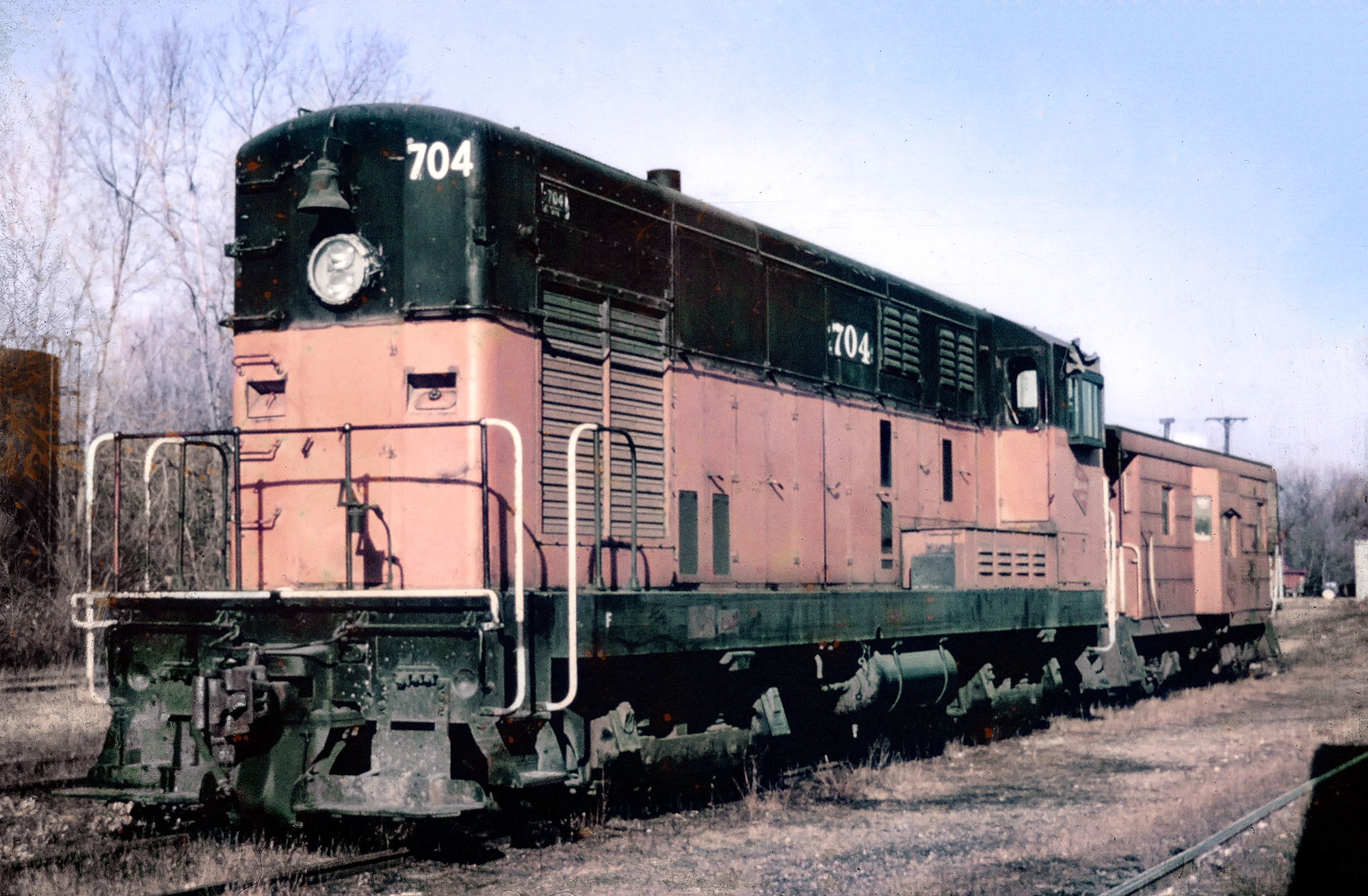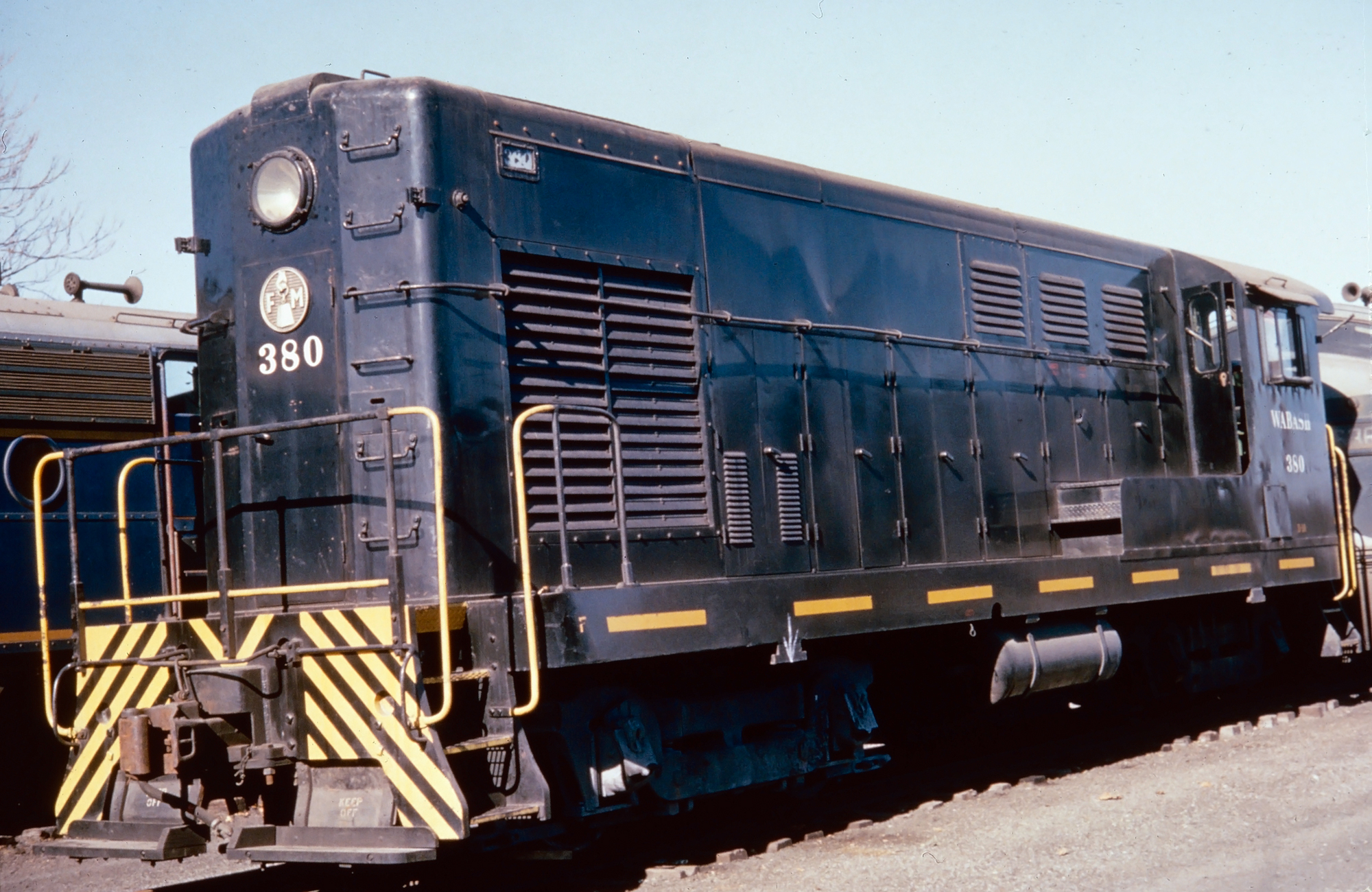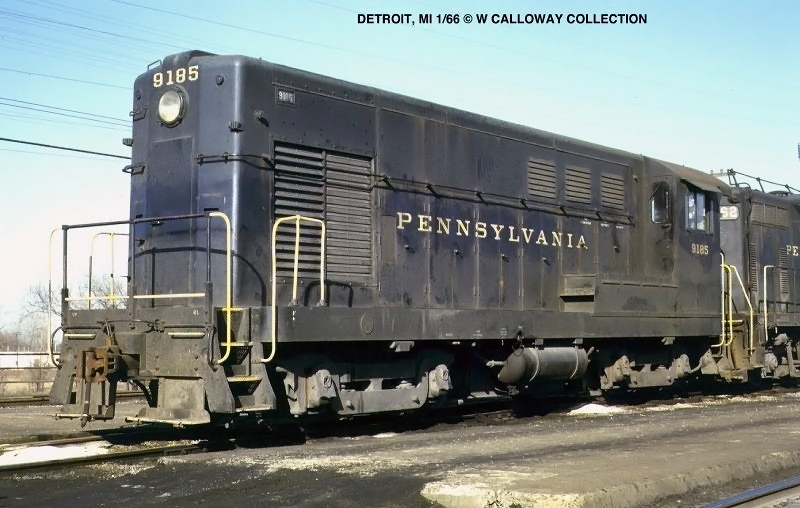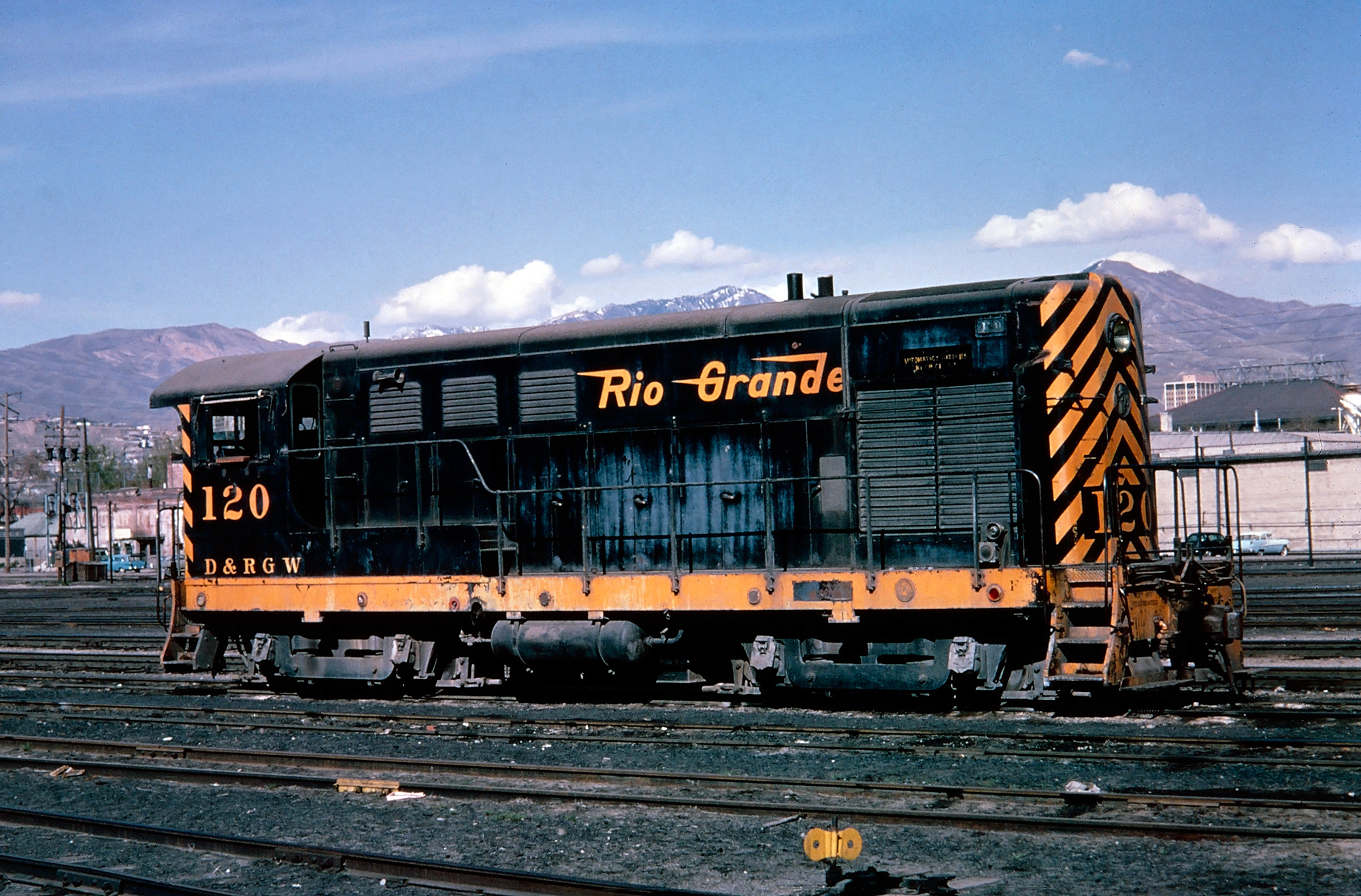FM "H10-44" Locomotives: Specs, Roster, History
Last revised: December 27, 2024
By: Adam Burns
The H10-44 was Fairbanks-Morse's first cataloged locomotive, and the first in its switcher line.
It was constructed during the latter half of the 1940s and sold
relatively well.
The H10-44 was originally designed for yard service. However, as is so often the case, railroads found the switcher suitable in all types of work, from switching to branch line duties.
The engine had proven itself in marine applications and when well understood by maintenance personnel operated fine in rail service.
The Southern Pacific and Canadian Pacific, for example, operated theirs for more than 20 years before age led to retirement.
Purely on the stance of reliability, FM's 38D8 1/8 opposed-piston (O-P) prime mover was the most reliable diesel engine of all the smaller builders (Alco and Baldwin).
H10-44's could be found in operation on many Class Is, from time they were cataloged in 1944 through the late 1970s, with some even surviving into the 1980's.
Photos
Overview
As John Kirkland points out in his book, "The Diesel Builders: Fairbanks-Morse And Lima-Hamilton," the heritage of what became the H10-44 has many "firsts" but can essentially be traced back to two test-bed models FM manufactured for the Southern Railway and Reading: a diesel-powered rail car and a small switcher.
The former was the first to utilize FM's 2-cycle, 38D8 1/8 O-P prime mover. The cars were essentially used for baggage with the carbodies manufactured by the St. Louis Car Company.
The six units numbered as Southern 1-4 and Alabama Great Southern 40-41, entered service in 1939. The rail cars could produce 800 horsepower and pulled powerless, 76-seat coaches (also built by St. Louis Car), numbered as Southern MT1-MT4 and Alabama Great Southern MT40-MT41.
All internal electrical equipment was supplied by Westinghouse, which also supplied Baldwin with most of its diesel locomotives.
The Reading's switcher, numbered 35, also entered service in 1939. It was, however, not powered by an O-P engine (but did utilize an FM prime mover). As such, it is recognized as the first locomotive to feature an FM diesel engine.
The switcher was also manufactured by St. Louis Car and somewhat resembled a beefed-up General Electric design from the same era.
It featured a pair of model 46A86, 4-cycle engines that could produce 300 horsepower each for a total of 600 horsepower.
Once again Westinghouse supplied all electrical equipment. After delivery to Reading on December 31, 1939 it entered service at Wayne Junction, Philadelphia on January 4, 1940. Soon after, the locomotive was renumbered 97.
The H10-44 began production in August, 1944; it was capable of producing 1,000 horsepower using Fairbanks Morse's 2-cycle 38D8 1/8 opposed-piston prime mover.
The 8-cylinder, 1,600 version of the O-P was touted by FM as having "237 fewer working parts than an EMD model 567-16 cylinder 8 ½" x 10" engine (1,500 horsepower) and 118 fewer working parts than an Alco model 244 12-cylinder 9" x 10 ½" engine (1,500 horsepower)."
There was also the advantage of having headless cylinders; the two pistons worked vertically within a central chamber.
Of course, the trade off was excess burn-off during startup as lube oil occasionally found its way into the exhaust gas passages and two crankshafts meant a more finely detailed understanding of maintaining the power plant.
The H10-44 featured B-B trucks and a high hood with the cab off-set to one end. As Mr. Kirkland notes, the switcher was essentially a Baldwin design with an O-P engine.
Fairbanks-Morse adopted many Baldwin features into its initial including the use, once more, of Westinghouse for all electrical equipment.
 Milwaukee Road H10-44 #704 is seen here between assignments at Ottumwa, Iowa in December, 1969. Fred Byerly photo. American-Rails.com collection.
Milwaukee Road H10-44 #704 is seen here between assignments at Ottumwa, Iowa in December, 1969. Fred Byerly photo. American-Rails.com collection.While some railroads and shop forces complained of FM's complicated opposed-piston design no one could argue with the incredible tractive effort and pulling power its locomotives offered.
For instance, the H10-44 could produce 72,000 pounds of starting tractive effort and 34,000 pounds continuous. Similar models offered by Alco and EMD could simply not match this; this ability, among other things, helped immensely in getting a train moving quickly.
FM's modeling designation was rather straightforward, although the use of "H" to designate "Hood" became confusing when the company released road-switchers with a similar hood only on a longer carbody.
The H10-44 stood for the following:
- "H" stood for Hood
- "10" was for 1,000 horsepower
- Each 4 regarded four axles and four traction motors
Reception
While the H10-44 was only marginally successful from a sales standpoint (195 units were ultimately produced), it is not necessarily because Fairbanks Morse's models were unreliable.
The engine was a proven rugged design as Kirkland notes; their issue were largely one of maintenance personnel being unfamiliar with them during an era when Electro-Motive was the primary motive power on many railroads.
 Wabash H10-44 #380 was photographed here at Decatur, Illinois on October 31, 1965. Photographer unknown. American-Rails.com collection.
Wabash H10-44 #380 was photographed here at Decatur, Illinois on October 31, 1965. Photographer unknown. American-Rails.com collection.During the course of production there was one major change to the H10-44, a switch from a 125-volt to 75-volt control system.
This was to conform to Association of American Railroads (AAR), industry standards. In doing so, Westinghouse switched to slightly different models of the electrical equipment it supplied FM, which will be noted in the below data sheets.
Baltimore & Ohio #306-307, completed in December, 1948, were the first units to feature the updated 75-volt system and internal equipment.
In addition, during the course of production, FM tried to enter the field of traction motors and its auxiliary equipment (generators, fans, etc.).
The first locomotives to use Westinghouse traction motors in conjunction with FM generators was a batch of nine units manufactured for the Nickel Plate Road between December, 1948 and April, 1949 (#125-133).
Later, the first units to roll out of Beloit with all FM electrical equipment was Wabash #382-383 in March, 1949. As Mr. Kirkland notes, FM's designs proved unsatisfactory and some future switchers reverted back to Westinghouse equipment.
Data Sheet and Specifications
125 Volt
| Entered Production | 8/21/1944 (Milwaukee Road #1802) |
| Years Produced | 8/1944 - 12/1948 |
| Fairbanks-Morse Class | H10-44 |
| Engine | 38D8 1/8, 6-cylinder Opposed-Piston |
| Engine Builder | Fairbanks-Morse |
| Horsepower | 1000 |
| RPM | 800 |
| Carbody Styling | Raymond Loewy |
| Length (Inside Couplers) | 48' 10" |
| Height (Top Of Rail To Top Of Cab) | 14' 6" |
| Width | 10' 2" |
| Weight | 240,000 Lbs |
| Trucks | B-B |
| Truck Type | GSC Rigid Bolster, Drop-Side Equalizer |
| Truck Wheelbase | 8' |
| Wheel Size | 40" |
| Traction Motors | 362D (4), Westinghouse |
| Traction Generator | 481A, Westinghouse |
| Auxiliary Generator | YG40C, Westinghouse |
| MU (Multiple-Unit) | Yes |
| Gear Ratio | 68:14 |
| Tractive Effort | 34,000 Lbs at 9 mph |
| Top Speed | 60 mph |
75 Volt
| Entered Production | 12/1948 (Baltimore & Ohio #306-307) |
| Years Produced | 12/1948 - 4/1950 |
| Fairbanks-Morse Class | H10-44 |
| Engine | 38D8 1/8, 6-cylinder Opposed-Piston |
| Engine Builder | Fairbanks-Morse |
| Horsepower | 1000 |
| RPM | 800 |
| Carbody Styling | Raymond Loewy |
| Length (Inside Couplers) | 48' 10" |
| Height (Top Of Rail To Top Of Cab) | 14' 6" |
| Width | 10' 2" |
| Weight | 240,000 Lbs |
| Trucks | B-B |
| Truck Type | GSC Rigid Bolster, Drop-Side Equalizer |
| Truck Wheelbase | 8' |
| Wheel Size | 40" |
| Traction Motors | 362D (4), Westinghouse |
| Traction Generator | 481F, Westinghouse |
| Auxiliary Generator | YG42A, Westinghouse |
| MU (Multiple-Unit) | Yes |
| Gear Ratio | 68:14 |
| Tractive Effort | 34,000 Lbs at 9 mph |
| Top Speed | 60 mph |
Production Roster
Total Built = 195
| Owner | Road Number | Construction Number | Contract Number | Completion Date |
|---|---|---|---|---|
| Milwaukee Road | 1802 | L1001 | LD1 | 8/1944 |
| Chicago & North Western | 1036 | L1002 | LD2 | 11/1944 |
| Santa Fe | 500 | L1003 | LD3 | 4/1945 |
| Union Pacific | DS1300 | L1004 | LD4 | 5/1945 |
| Milwaukee Road | 1803-1812 | L1005-L1014 | LD5 | 6/1945-12/1945 |
| Chicago & North Western | 1048-1050 | L1015-L1017 | LD7 | 9/1946 |
| Chicago & North Western | 1051 | L1018 | LD7 | 10/1946 |
| Minnesota Western Railway | 51 | L1019 | LD10 | 9/1946 |
| Monon Railroad | 18 | L1020 | LD13 | 11/1946 |
| Wabash Railroad | 380-381 | L1021-L1022 | LD14 | 11/1946 |
| Pittsburgh & Lake Erie (New York Central) | 8800-8801 | L1023-L1024 | LD15 | 12/1946 |
| Union Pacific | DS1301-DS1304 | L1025-L1028 | LD17 | 2/1947 |
| Terminal Railroad Association Of St. Louis | 700-701 | L1029-L1030 | LD18 | 3/1947 |
| Apache Railway | 100 | L1081 | LD23 | 10/1947 |
| Kentucky & Indiana Terminal Railroad | 48 | L1082 | LD27 | 10/1947 |
| Kentucky & Indiana Terminal Railroad | 49-50 | L1083-L1084 | LD27 | 11/1947 |
| Chicago & North Western | 1052-1053 | L1085-L1086 | LD24 | 11/1947 |
| Chicago & North Western (Chicago, St. Paul, Minneapolis & Omaha) | 94 | L1171 | LD26 | 12/1947 |
| Chicago & North Western | 1054-1055 | L1172-L1173 | LD24 | 1/1948 |
| Chicago & North Western (Chicago, St. Paul, Minneapolis & Omaha) | 95-98 | 10L40-10L43 | LD26 | 2/1948 |
| Kentucky & Indiana Terminal Railroad | 51 | 10L44 | LD27 | 3/1948 |
| Milwaukee Road | 1819 | 10L45 | LD84 | 3/1948 |
| Kentucky & Indiana Terminal Railroad | 52 | 10L46 | LD27 | 3/1948 |
| St. Louis-San Francisco Railway (Frisco) | 270-275 | 10L47-10L52 | LD30 | 3/1948 |
| Denver & Rio Grande Western | 120-122 | 10L53-10L55 | LD37 | 4/1948 |
| Santa Fe | 501-502 | 10L56-10L57 | LD32 | 4/1948 |
| Denver & Rio Grande Western | 123 | 10L58 | LD37 | 4/1948 |
| Chicago & North Western | 1082 | 10L59 | LD25 | 6/1948 |
| Weyerhaeuser Timber | 481 | 10L60 | LD48 | 4/1948 |
| Pennsylvania | 5980-5982 | 10L61-10L63 | LD50 | 6/1948 |
| Pittsburgh & Lake Erie (New York Central) | 8902-8903 | 10L64-10L65 | LD33 | 8/1948 |
| Pennsylvania | 5983-5986 | 10L66-10L69 | LD50 | 6/1948 |
| Pennsylvania | 9184-9186 | 10L70-10L72 | LD50 | 6/1948 |
| Pennsylvania | 9187 | 10L73 | LD50 | 7/1948 |
| Pennsylvania | 9188-9191 | 10L74-10L77 | LD50 | 8/1948 |
| Pennsylvania | 9192-9196 | 10L78-10L82 | LD50 | 9/1948 |
| St. Louis San Francisco Railway (Frisco) | 276-278 | 10L83-10L85 | LD52 | 9/1948 |
| Baltimore & Ohio | 300-301 | 10L86-10L87 | LD51 | 11/1948 |
| Baltimore & Ohio | 302-309 | 10L88-10L95 | LD51 | 12/1948 |
| Pennsylvania | 9197-9198 | 10L96-10L97 | LD50 | 9/1948 |
| Pennsylvania | 9199 | 10L98 | LD50 | 10/1948 |
| St. Louis San Francisco Railway (Frisco) | 279 | 10L99 | LD52 | 10/1948 |
| Apache Railway | 200 | 10L100 | LD68 | 11/1948 |
| Wabash Railroad | 382-383 | 10L101-10L102 | LD57 | 3/1949 |
| New York, Chicago & St. Louis (Nickel Plate Road) | 125 | 10L103 | LD67 | 12/1948 |
| New York, Chicago & St. Louis (Nickel Plate Road) | 126 | 10L104 | LD67 | 1/1949 |
| New York, Chicago & St. Louis (Nickel Plate Road) | 127-128 | 10L105-10L106 | LD67 | 2/1949 |
| New York, Chicago & St. Louis (Nickel Plate Road) | 129-130 | 10L107-10L108 | LD67 | 3/1949 |
| New York, Chicago & St. Louis (Nickel Plate Road) | 131-133 | 10L109-10L111 | LD67 | 4/1949 |
| Milwaukee Road | 1813-1815 | 10L112-10L114 | LD56 | 1/1949 |
| Milwaukee Road | 1816-1818 | 10L115-10L117 | LD56 | 2/1949 |
| Terminal Railroad Association Of St. Louis | 702-703 | 10L118-10L119 | LD59 | 4/1949 |
| Pennsylvania | 9288-9293 | 10L120-10L125 | LD53 | 3/1949 |
| Pennsylvania | 9294-9299 | 10L126-10L131 | LD53 | 4/1949 |
| St. Louis San Francisco Railway (Frisco) | 280 | 10L132 | LD54 | 6/1949 |
| St. Louis San Francisco Railway (Frisco) | 281 | 10L133 | LD54 | 7/1949 |
| Chicago & North Western | 1056 | 10L134 | LD63 | 6/1949 |
| Chicago & North Western | 1057 | 10L135 | LD63 | 7/1949 |
| Chicago & North Western | 1058 | 10L136 | LD63 | 8/1949 |
| Chicago & North Western | 1059 | 10L137 | LD63 | 7/1949 |
| Chicago & North Western | 1060-1062 | 10L138-10L140 | LD63 | 8/1949 |
| Kentucky & Indiana Terminal Railroad | 55-59 | 10L141-10L145 | LD69 | 5/1949 |
| New York Central | 8904-8905 | 10L146-10L147 | LD60 | 6/1949 |
| Chehalis Western Railroad (Weyerhaeuser) | 492 | 10L148 | LD60 | 5/1949 |
| Chehalis Western Railroad (Weyerhaeuser) | 493 | 10L149 | LD60 | 6/1949 |
| Pennsylvania | 9080 | 10L150 | LD71 | 7/1949 |
| Pennsylvania | 9081 | 10L151 | LD71 | 8/1949 |
| Pennsylvania | 9082-9090 | 10L152-10L150 | LD71 | 9/1949 |
| Pennsylvania | 9091 | 10L161 | LD71 | 10/1949 |
| Pennsylvania | 9092 | 10L162 | LD71 | 9/1949 |
| Pennsylvania | 9093-9097 | 10L163-10L167 | LD71 | 10/1949 |
| Pennsylvania | 9098-9099 | 10L168-10L169 | LD71 | 11/1949 |
| New York Central | 9106-9107 | 10L170-10L171 | LD73 | 11/1949 |
| New York Central | 9108-9109 | 10L172-10L173 | LD73 | 12/1949 |
| Columbia & Cowlitz Railway (Weyerhaeuser) | D1 | 10L174 | LD75 | 6/1949 |
| Pittsburgh, Chartiers & Youghiogheny Railway | 1 | 10L175 | LD79 | 6/1949 |
| New York Central | 9110 | 10L176 | LD77 | 2/1950 |
| Chicago & North Western | 1063 | 10L284 | LD76 | 12/1949 |
| Chicago & North Western | 1064-1065 | 10L285-10L286 | LD76 | 1/1950 |
| Chicago & North Western | 1070 | 10L287 | LD76 | 1/1950 |
| Indianapolis Union Railway | 10-11 | 10L300-10L301 | LD81 | 8/1949 |
| Indianapolis Union Railway | 12-13 | 10L302-10L303 | LD81 | 11/1949 |
| Milwaukee Road | 1820-1822 | 10L325-10L327 | LD85 | 2/1950 |
| Milwaukee Road | 1823-1825 | 10L328-10L330 | LD85 | 3/1950 |
| Indianapolis Union Railway | 14 | 10L363 | LD90 | 3/1950 |
| Indianapolis Union Railway | 15-18 | 10L364-10L367 | LD90 | 4/1950 |
Sources
- Kirkland, John F. Diesel Builders, The: Fairbanks-Morse And Lima-Hamilton. Glendale: Interurban Press, 1985.
- Pinkepank, Jerry A. Diesel Spotter's Guide. Milwaukee: Kalmbach Publishing Company, 1967.
- Schafer, Mike. Vintage Diesel Locomotives. Osceola: MBI Publishing, 1998.
By the time production had ended on the H10-44 in April of 1950 Fairbanks Morse had sold 195 units to a wide range of Class I and smaller railroads (the PRR purchased the most, 55).
Today, at least three FM H10-44s are known to be preserved, all of which are former Milwaukee Road units; #760, #767, and #781.
The former unit #760) was the first ever produced by Fairbanks Morse and is one of the only examples of its diesels that is still in operating condition at the Illinois Railway Museum.
Recent Articles
-
Oregon Railroad Museums: A Complete Guide
Apr 25, 25 03:11 PM
With its rich tapestry of scenic landscapes and profound historical significance, Oregon possesses several railroad museums that offer insights into the state’s transportation heritage. -
North Carolina Railroad Museums: A Complete Guide
Apr 25, 25 02:56 PM
Today, several museums in North Caorlina preserve its illustrious past, offering visitors a glimpse into the world of railroads with artifacts, model trains, and historic locomotives. -
New Jersey Railroad Museums: A Complete Guide
Apr 25, 25 11:48 AM
New Jersey offers a fascinating glimpse into its railroad legacy through its well-preserved museums found throughout the state.



